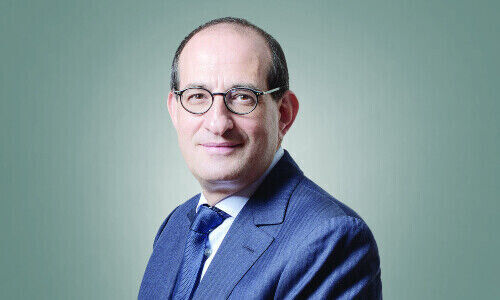The IT outage that disrupted the whole planet last July was a painful reminder that technology is not 100 percent reliable. Similarly, financial standards do not protect against all risks, Philip Adler writes in his article on finews.first.
finews.first is a forum for authors to comment on economic and financial topics.
The season of the first-half results for Swiss banks is in full swing. These announcements can sometimes seem like an alphabet soup, with terms like CET1, LCR and NSFR representing financial ratios that are meant to help assess a bank’s solvency. If you have ever been left scratching your head by these terms, this article contains everything you ever wanted to know about these ratios but were afraid to ask.
For both regulators and analysts, assessing the solvency of banks is part of their job description. To help them, they have a whole set of ratios at their disposal. The best known is probably the capital ratio, which measures the relationship between a bank’s available capital – mainly consisting of its ordinary share capital and retained earnings, minus any goodwill – and its total risk-weighted assets.
The minimum capital ratio is 10.5 percent for a smaller local bank, and 12.8 percent for an international systemically important bank. FINMA can also raise the requirement on a case-by-case basis. Available capital is there to absorb financial losses and keep a bank stable in the event of a crisis.
«The LCR measures a bank’s ability to cope with a bank run»
The aim of the Liquidity Coverage Ratio or LCR is to ensure that a bank has enough of a liquidity buffer to deal with large cash outflows over 30 days. The LCR therefore measures a bank’s ability to cope with a bank run and must be over 100 percent.
The Net Stable Funding Ratio or NSFR assesses a bank’s long-term liquidity and therefore its structural resilience, showing whether it can maintain a stable funding profile over one year. The NSFR must also be over 100 percent.
Finally, a bank’s leverage ratio measures its solvency by comparing its core capital with its total non-risk-weighted assets, i.e. its outstanding debt. It must generally be over 3 percent, ensuring that the bank is not taking too many risks.
For all of these ratios, asset- and wealth-management banks usually have figures well over the required minimums because of their business models and the way they are managed.
«Same rules for all banks would probably have prevented the collapse of Silicon Valley Bank»
Supervisory authorities therefore have several tools available to them. However, there are regional differences. Europe – including the UK and Switzerland – has adopted uniform regulations, but that is not the case in the US. While all European banks must meet the higher ratio requirements set out in the Basel III agreements, some smaller US banks only have to meet the Basel I requirements. Applying the same rules to all banks would probably have prevented the collapse of Silicon Valley Bank: its LCR was high enough, but its NSFR was not, which should have been a red flag.
As shown by the adoption of Basel III in response to the 2008 financial crisis, the supervisory authorities are constantly adapting and their requirements change in line with events and technological progress. For example, Swiss rules on granting mortgages were tightened following the 1990s real estate crisis.
Although the resulting rules are often criticized by proponents of property ownership, they very likely helped prevent the market from overheating and avoided a wave of defaults – and therefore personal bankruptcies – when interest rates rose in late 2021.
«Many pitfalls can be avoided through a good dose of common sense»
Given the extent of economic and geopolitical difficulties in recent years, it is safe to say that the banking regulators have done their job. Thanks to the various ratio requirements and the stress tests introduced by central banks and regulators to simulate banks’ ability to withstand extreme economic and financial conditions, it is clear that risks relating to banks’ capital and ability to absorb losses are being adequately assessed. We are likely to see another example of the regulators’ adaptability soon with respect to liquidity risk, given the current review of what counts as a high-quality liquid asset (HQLA) in the LCR calculation.
Although some fear new technologies, they should make it easier for banks to have a comprehensive, real-time overview of their balance sheet position. They should also be of assistance to regulators and central banks, helping them to be even more accurate and responsive in fulfilling their supervisory role. Innovations are not a risk in themselves: it all depends on how they are used.
Of course, the IT outage that disrupted the whole planet last July was a painful reminder that technology is not 100 percent reliable. Similarly, financial standards do not protect against all risks. Undoubtedly, the best way of dealing with the emergence of hitherto unknown dangers is to have responsive institutions, central banks, regulators, and politicians.
Naturally, many pitfalls can be avoided through a good dose of common sense and a conservative attitude. After all, as the saying goes, you can never be too careful.
Philip Adler is the Global Head of Treasury & Trading at Geneva-based Union Bancaire Privée.
Previous contributions: Rudi Bogni, Peter Kurer, Rolf Banz, Dieter Ruloff, Werner Vogt, Walter Wittmann, Alfred Mettler, Robert Holzach, Craig Murray, David Zollinger, Arthur Bolliger, Beat Kappeler, Chris Rowe, Stefan Gerlach, Marc Lussy, Nuno Fernandes, Richard Egger, Maurice Pedergnana, Marco Bargel, Steve Hanke, Urs Schoettli, Ursula Finsterwald, Stefan Kreuzkamp, Oliver Bussmann, Michael Benz, Albert Steck, Martin Dahinden, Thomas Fedier, Alfred Mettler, Brigitte Strebel, Mirjam Staub-Bisang, Nicolas Roth, Thorsten Polleit, Kim Iskyan, Stephen Dover, Denise Kenyon-Rouvinez, Christian Dreyer, Kinan Khadam-Al-Jame, Robert Hemmi, Anton Affentranger, Yves Mirabaud, Katharina Bart, Frédéric Papp, Hans-Martin Kraus, Gerard Guerdat, Mario Bassi, Stephen Thariyan, Dan Steinbock, Rino Borini, Bert Flossbach, Michael Hasenstab, Guido Schilling, Werner E. Rutsch, Dorte Bech Vizard, Katharina Bart, Maya Bhandari, Jean Tirole, Hans Jakob Roth, Marco Martinelli, Thomas Sutter, Tom King, Werner Peyer, Thomas Kupfer, Peter Kurer, Arturo Bris, Frederic Papp, James Syme, Dennis Larsen, Bernd Kramer, Armin Jans, Nicolas Roth, Hans Ulrich Jost, Patrick Hunger, Fabrizio Quirighetti, Claire Shaw, Peter Fanconi, Alex Wolf, Dan Steinbock, Patrick Scheurle, Sandro Occhilupo, Will Ballard, Nicholas Yeo, Claude-Alain Margelisch, Jean-François Hirschel, Jens Pongratz, Samuel Gerber, Philipp Weckherlin, Anne Richards, Antoni Trenchev, Benoit Barbereau, Pascal R. Bersier, Shaul Lifshitz, Klaus Breiner, Ana Botín, Martin Gilbert, Jesper Koll, Ingo Rauser, Carlo Capaul, Markus Winkler, Thomas Steinemann, Christina Boeck, Guillaume Compeyron, Miro Zivkovic, Alexander F. Wagner, Eric Heymann, Christoph Sax, Felix Brem, Jochen Moebert, Jacques-Aurélien Marcireau, Ursula Finsterwald, Michel Longhini, Stefan Blum, Zsolt Kohalmi, Nicolas Ramelet, Søren Bjønness, Gilles Prince, Salman Ahmed, Peter van der Welle, Ken Orchard, Christian Gast, Jeffrey Bohn, Juergen Braunstein, Jeff Voegeli, Fiona Frick, Stefan Schneider, Matthias Hunn, Andreas Vetsch, Fabiana Fedeli, Kim Fournais, Carole Millet, Swetha Ramachandran, Thomas Stucki, Neil Shearing, Tom Naratil, Oliver Berger, Robert Sharps, Tobias Mueller, Florian Wicki, Jean Keller, Niels Lan Doky, Johnny El Hachem, Judith Basad, Katharina Bart, Thorsten Polleit, Peter Schmid, Karam Hinduja, Zsolt Kohalmi, Raphaël Surber, Santosh Brivio, Mark Urquhart, Olivier Kessler, Bruno Capone, Peter Hody, Michael Bornhaeusser, Agnieszka Walorska, Thomas Mueller, Ebrahim Attarzadeh, Marcel Hostettler, Hui Zhang, Michael Bornhaeusser, Reto Jauch, Angela Agostini, Guy de Blonay, Tatjana Greil Castro, Jean-Baptiste Berthon, Marc Saint John Webb, Dietrich Goenemeyer, Mobeen Tahir, Didier Saint-Georges, Serge Tabachnik, Vega Ibanez, David Folkerts-Landau, Andreas Ita, Michael Welti, Fabrizio Pagani, Roman Balzan, Todd Saligman, Stuart Dunbar, Carina Schaurte, Birte Orth-Freese, Gun Woo, Lamara von Albertini, Ramon Vogt, Andrea Hoffmann, Niccolò Garzelli, Darren Williams, Benjamin Böhner, Mike Judith, Jared Cook, Henk Grootveld, Roman Gaus, Nicolas Faller, Anna Stünzi, Thomas Höhne-Sparborth, Fabrizio Pagani, Guy de Blonay, Jan Boudewijns, Sean Hagerty, Alina Donets, Sébastien Galy, Roman von Ah, Fernando Fernández, Georg von Wyss, Stefan Bannwart, Andreas Britt, Frédéric Leroux, Nick Platjouw, Rolando Grandi, Philipp Kaupke, Gérard Piasko, Brad Slingerlend, Dieter Wermuth, Grégoire Bordier, Thomas Signer, Gianluca Gerosa, Christine Houston, Manuel Romera Robles, Fabian Käslin, Claudia Kraaz, Marco Huwiler, Lukas Zihlmann, Sherif Mamdouh, Harald Preissler, Taimur Hyat, Philipp Cottier, Andreas Herrmann, Camille Vial, Marcus Hüttinger, Serge Beck, Alannah Beer, Stéphane Monier, Ashley Simmons, Lars Jaeger, Shanna Strauss-Frank, Bertrand Binggeli, Marionna Wegenstein, George Muzinich, Jian Shi Cortesi, Razan Nasser, Nicolas Forest, Joerg Ruetschi, Reto Jauch, Bernardo Brunschwiler, Charles-Henry Monchau, Philip Adler, Ha Duong, Teodoro Cocca, Jan Brzezek, Nicolas Mousset, Beat Weiss, Pascal Mischler, Andrew Isbester, Konrad Hummler, Jan Beckers, Martin Velten, Katharine Neiss, Claude Baumann, Daniel Roarty, Kubilay Yalcin, Robert Almeida, Karin M. Klossek, Marc Taverner, Charlie T. Munger, Daniel Kobler, Patrick Stauber, Colin Vidal, Anna Rosenber, Judith Wallenstein, Adriano Lucatelli, Daniel Goleman, Val Olson, Brice Prunas, Francesco Magistra, Frances Weir, Luis Maldonado, Francesco Magistra, Nadège Lesueur-Pène, Massimo Pedrazzini, Eric Sarasin, David Ellis, Dina Ting, Christopher Gannatti, Shaniel Ramjee, Mihkel Vitsur, Nannette Hechler-Fayd’herbe, Ralph Ebert, Chris Cottorone, Francesco Mandalà, Mariolina Esposito, Maryann Umoren Selfe, Dominique Gerster, Marc Arand, Christian Kälin, Nadège Dufossé, Benjamin Melman, Brigitte Kaps, Florin Baeriswyl, Marc Reinhardt, Thomas Holderegger, Beat Wittmann, Bruno Cavalier, Gary Burnison, Louise Curran, and Adrian Cox.


























